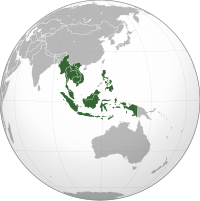
Photo from wikipedia
Introduction In Mexico, the main institution of social security is the “Instituto Mexicano del Seguro Social” (IMSS), with more than 60 million enrolled individuals. This study of childhood cancer survival… Click to show full abstract
Introduction In Mexico, the main institution of social security is the “Instituto Mexicano del Seguro Social” (IMSS), with more than 60 million enrolled individuals. This study of childhood cancer survival is the first based on complete cohorts of incident cases for the population IMSS- affiliated in the central-south region, which represents 27% of all children IMSS affiliated. Methods It is an observational cohort study from 2006 to 2012 to estimate the 5-year observed survival of the minors under 18 years old, identified in the Central-South Region Registry of Children with Cancer. The survival of cases was carried out through the active and passive search. Survival rates were estimated by the Kaplan–Meier (KM) method, the analysis of equality of survival functions was evaluated for some clinical variables. Results The study included 2,357 minors; the 5-year observed survival was 56.1% with a time of survival median of 3.4 years, and the overall loss of follow-up was 18.4%. The 5-year survival in cases with a diagnosis of leukemia was 53.5%, while for solid tumors, it was 57.9%. The median time of death was 1 year. The types of cancer with a survival greater than 70% were group V-retinoblastoma (87.2%), IIa-Hodgkin’s lymphoma (86.8%), Xc- gonadal tumors (83.3%), Iid-miscellaneous lymphomas (80%), IVa-nephroblastoma (79.5%), and IIc-Burkitt’s lymphoma (75.4%). Meanwhile, the lowest survival rates were in group VIII-bone tumors (32.3%), III-CNS (central nervous system; 44.1%), and IX-soft tissues (46.8%). Conclusions Survival results in the 2006–2012 cohorts show a significant gap in relation to the goal of 60% proposed by the World Health Organization for 2030.
Journal Title: Frontiers in Oncology
Year Published: 2022
Link to full text (if available)
Share on Social Media: Sign Up to like & get
recommendations!